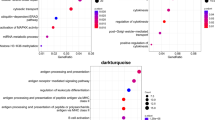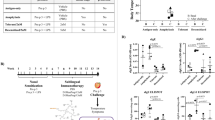Abstract
We performed a network-based analysis of DNA microarray data from allergen-challenged CD4+ T cells from patients with seasonal allergic rhinitis. Differentially expressed genes were organized into a functionally annotated network using the Ingenuity Knowledge Database, which is based on manual review of more than 200 000 publications. The main function of this network is the regulation of lymphocyte apoptosis, a role associated with several genes of the tuber necrosis factor superfamily. The expression of TNFRSF4, one of the genes in this family, was found to be 48 times higher in allergen-challenged cells than in diluent-challenged cells. TNFRSF4 is known to inhibit apoptosis and to enhance Th2 proliferation. Examination of a different material of allergen-stimulated peripheral blood mononuclear cells showed a higher number of interleukin-4+ type 2 CD4+ T (Th2) cells in patients than in controls (P<0.01), as well as a higher number of non-apoptotic Th2 cells in patients (P<0.01). The number of Th2 cells expressing TNFRSF4, TNFSF7 and TNFRSF1B was also significantly higher in patients. Treatment with anti-TNFSF4 resulted in a significantly decreased number of Th2 cells (P<0.05). A logical inference from all this is that the proliferation of allergen-challenged Th2 cells is associated with a decreased apoptosis of Th2 cells and an increase in TNFRSF4 signalling.
This is a preview of subscription content, access via your institution
Access options
Subscribe to this journal
Receive 6 digital issues and online access to articles
$119.00 per year
only $19.83 per issue
Buy this article
- Purchase on Springer Link
- Instant access to full article PDF
Prices may be subject to local taxes which are calculated during checkout



Similar content being viewed by others
References
Murphy KM, Reiner SL . The lineage decisions of helper T cells. Nat Rev Immunol 2002; 2: 933–944.
Zhang X, Brunner T, Carter L, Dutton RW, Rogers P, Bradley L et al. Unequal death in T helper cell (Th)1 and Th2 effectors: Th1, but not Th2, effectors undergo rapid Fas/FasL-mediated apoptosis. J Exp Med 1997; 185: 1837–1849.
Akdis M, Trautmann A, Klunker S, Daigle I, Kucuksezer UC, Deglmann W et al. T helper (Th) 2 predominance in atopic diseases is due to preferential apoptosis of circulating memory/effector Th1 cells. FASEB J 2003; 17: 1026–1035.
Sehra S, Patel D, Kusam S, Wang ZY, Chang CH, Dent AL . A role for caspases in controlling IL-4 expression in T cells. J Immunol 2005; 174: 3440–3446.
Tseveleki V, Bauer J, Taoufik E, Ruan C, Leondiadis L, Haralambous S et al. Cellular FLIP (long isoform) overexpression in T cells drives Th2 effector responses and promotes immunoregulation in experimental autoimmune encephalomyelitis. J Immunol 2004; 173: 6619–6626.
Wu W, Rinaldi L, Fortner KA, Russell JQ, Tschopp J, Irvin C et al. Cellular FLIP long form-transgenic mice manifest a Th2 cytokine bias and enhanced allergic airway inflammation. J Immunol 2004; 172: 4724–4732.
Benson M, Adner M, Cardell LO . Cytokines and cytokine receptors in allergic rhinitis: how do they relate to the Th2 hypothesis in allergy? Clin Exp Allergy 2001; 31: 361–367.
Hamalainen H, Zhou H, Chou W, Hashizume H, Heller R, Lahesmaa R . Distinct gene expression profiles of human type 1 and type 2 T helper cells. Genome Biol 2001; 2: 0022.1–0022.11.
Chtanova T, Newton R, Liu SM, Weininger L, Young TR, Silva DG et al. Identification of T cell-restricted genes, and signatures for different T cell responses, using a comprehensive collection of microarray datasets. J Immunol 2005; 175: 7837–7847.
Chen L, Martinez O, Overbergh L, Mathieu C, Prabhakar BS, Chan LS . Early up-regulation of Th2 cytokines and late surge of Th1 cytokines in an atopic dermatitis model. Clin Exp Immunol 2004; 138: 375–387.
Hijnen D, Nijhuis E, Bruin-Weller M, Holstege F, Koerkamp MG, Kok I et al. Differential expression of genes involved in skin homing, proliferation, and apoptosis in CD4+ T cells of patients with atopic dermatitis. J Invest Dermatol 2005; 125: 1149–1155.
Barabasi AL, Oltvai ZN . Network biology: understanding the cell's functional organization. Nat Rev Genet 2004; 5: 101–113.
Jeong H, Mason SP, Barabasi AL, Oltvai ZN . Lethality and centrality in protein networks. Nature 2001; 411: 41–42.
Calvano SE, Xiao W, Richards DR, Felciano RM, Baker HV, Cho RJ et al. A network-based analysis of systemic inflammation in humans. Nature 2005; 437: 1032–1037.
Froidevaux C, Roger T, Martin C, Glauser MP, Calandra T . Macrophage migration inhibitory factor and innate immune responses to bacterial infections. Crit Care Med 2001; 29: S13–S15.
Boonstra A, Barrat FJ, Crain C, Heath VL, Savelkoul HF, O'Garra A . 1Alpha,25-dihydroxyvitamin d3 has a direct effect on naive CD4(+) T cells to enhance the development of Th2 cells. J Immunol 2001; 167: 4974–4980.
Lugli SM, Feng N, Heim MH, Adam M, Schnyder B, Etter H et al. Tumor necrosis factor alpha enhances the expression of the interleukin (IL)-4 receptor alpha-chain on endothelial cells increasing IL-4 or IL-13-induced Stat6 activation. J Biol Chem 1997; 272: 5487–5494.
Pimentel-Muinos FX, Munoz-Fernandez MA, Fresno M . Control of T lymphocyte activation and IL-2 receptor expression by endogenously secreted lymphokines. J Immunol 1994; 152: 5714–5722.
Rivino L, Messi M, Jarrossay D, Lanzavecchia A, Sallusto F, Geginat J . Chemokine receptor expression identifies pre-T helper (Th)1, pre-Th2, and nonpolarized cells among human CD4+ central memory T cells. J Exp Med 2004; 200: 725–735.
Hornung F, Scala G, Lenardo MJ . TNF-alpha-induced secretion of C–C chemokines modulates C–C chemokine receptor 5 expression on peripheral blood lymphocytes. J Immunol 2000; 164: 6180–6187.
Kallinich T, Beier KC, Gelfand EW, Kroczek RA, Hamelmann E . Co-stimulatory molecules as potential targets for therapeutic intervention in allergic airway disease. Clin Exp Allergy 2005; 35: 1521–1534.
Humphreys IR, Edwards L, Walzl G, Rae AJ, Dougan G, Hill S et al. OX40 ligation on activated T cells enhances the control of Cryptococcus neoformans and reduces pulmonary eosinophilia. J Immunol 2003; 170: 6125–6132.
Akdis M, Verhagen J, Taylor A, Karamloo F, Karagiannidis C, Crameri R et al. Immune responses in healthy and allergic individuals are characterized by a fine balance between allergen-specific T regulatory 1 and T helper 2 cells. J Exp Med 2004; 199: 1567–1575.
Irizarry RA, Bolstad BM, Collin F, Cope LM, Hobbs B, Speed TP . Summaries of Affymetrix GeneChip probe level data. Nucleic Acids Res 2003; 31: e15.
Smyth GK . Linear models and empirical Bayes methods for assessing differential expression in microarray experiments. Stat Appl Genet Mol Biol 2004; 3: Article3. Available at http://www.bepress.com/sagmb/vol3/iss1/art3
Aggarwal BB . Signalling pathways of the TNF superfamily: a double-edged sword. Nat Rev Immunol 2003; 3: 745–756.
Ito T, Amakawa R, Inaba M, Hori T, Ota M, Nakamura K et al. Plasmacytoid dendritic cells regulate Th cell responses through OX40 ligand and type I IFNs. J Immunol 2004; 172: 4253–4259.
Irizarry RA, Warren D, Spencer F, Kim IF, Biswal S, Frank BC et al. Multiple-laboratory comparison of microarray platforms. Nat Methods 2005; 2: 345–350.
Salek-Ardakani S, Song J, Halteman BS, Jember AG, Akiba H, Yagita H et al. OX40 (CD134) controls memory T helper 2 cells that drive lung inflammation. J Exp Med 2003; 198: 315–324.
Kroczek R, Hamelmann E . T-cell costimulatory molecules: optimal targets for the treatment of allergic airway disease with monoclonal antibodies. J Allergy Clin Immunol 2005; 116: 906–909.
Burgess JK, Blake AE, Boustany S, Johnson PR, Armour CL, Black JL et al. CD40 and OX40 ligand are increased on stimulated asthmatic airway smooth muscle. J Allergy Clin Immunol 2005; 115: 302–308.
Picker LJ, Singh MK, Zdraveski Z, Treer JR, Waldrop SL, Bergstresser PR et al. Direct demonstration of cytokine synthesis heterogeneity among human memory/effector T cells by flow cytometry. Blood 1995; 86: 1408–1419.
Svahn A, Linde A, Thorstensson R, Karlen K, Andersson L, Gaines H . Development and evaluation of a flow-cytometric assay of specific cell-mediated immune response in activated whole blood for the detection of cell-mediated immunity against varicella-zoster virus. J Immunol Methods 2003; 277: 17–25.
Acknowledgements
We thank Jörgen Nedergaard-Larsen of ALK for kindly providing allergen extract and advice concerning the extract. This study was supported by grants from the US National Institutes of Health, the Swedish Medical Research Council, the, Sahlgrenska Academy and the Swedish Asthma and Allergy Foundation.
Author information
Authors and Affiliations
Corresponding author
Rights and permissions
About this article
Cite this article
Benson, M., Carlsson, L., Guillot, G. et al. A network-based analysis of allergen-challenged CD4+ T cells from patients with allergic rhinitis. Genes Immun 7, 514–521 (2006). https://doi.org/10.1038/sj.gene.6364322
Received:
Revised:
Accepted:
Published:
Issue Date:
DOI: https://doi.org/10.1038/sj.gene.6364322
Keywords
This article is cited by
-
Multi–omic analysis of signalling factors in inflammatory comorbidities
BMC Bioinformatics (2018)
-
Comprehensive Profiling of Peripheral Immune Cells and Subsets in Patients with Intermittent Allergic Rhinitis Compared to Healthy Controls and After Treatment with Glucocorticoids
Inflammation (2013)
-
Highly interconnected genes in disease-specific networks are enriched for disease-associated polymorphisms
Genome Biology (2012)
-
Introducing Dynamics into the Field of Biosemiotics
Biosemiotics (2011)
-
Peripheral blood gene expression in alopecia areata reveals molecular pathways distinguishing heritability, disease and severity
Genes & Immunity (2010)



